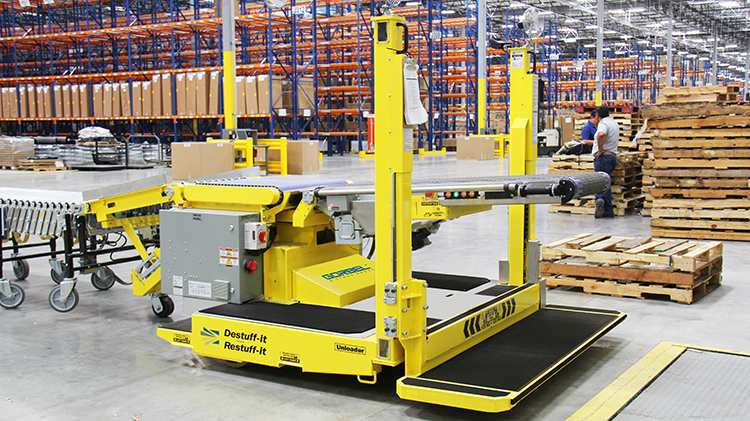E-Commerce and Ergonomics: How Portable Ergonomic Conveyors Reduce The Risk Of Worker Injury

This post is part of the EASE Council’s Educational Series: E-Commerce and Ergonomics
One of the most ergonomically taxing jobs in an e-commerce warehouse or fulfillment center is unloading and loading floor-stacked cartons in shipping containers or trailers. While this methodology maximizes transport cube, it also requires workers to bend, stretch, reach, pull, push, and lift cartons. Each of these actions can increase the risk of a worker sustaining a musculoskeletal injury. Yet, with U.S. e-commerce sales forecast to exceed $1.1 trillion in sales in 2023, manual unloading and loading of cases and cartons is unlikely to slow. Ergonomic assist equipment such as portable ergonomic conveyors that reduce the risk of worker injury are making these tasks less challenging.
What Are Portable Ergonomic Conveyors?
As powered, self-contained units, portable ergonomic conveyors drive into and out of a shipping container or trailer under the direction of the operator. In addition to motorized drive wheels, they also incorporate powered conveyor belt, operator platform, and a mechanical lift and lower function.

When unloading, the operator advances the unit to the wall of product, raises the platform and conveyor up, and guides cartons onto the conveyor belt for automatic takeaway. The conveyor belt transports the cartons out of the container or trailer along additional lengths of conveyor line located in the dock area. There, an automated palletizer or one or more associates sort cartons to individual pallets. Conversely, the conveyor can transfer the cartons to another conveyor or sorter for transport elsewhere within the facility.
As the operator works their way down from the container or trailer ceiling to the floor, they simultaneously direct the portable ergonomic conveyor unit to lower to floor level. Because the conveyor rises and lowers to match the height of the stacked cartons, operators no longer have to stretch, reach, or bend to move the cartons. Upon finishing a vertical layer of stacked cartons, the operator advances the unit forward and the process begins again.
Loading a trailer follows the same process, only in reverse. Each carton feeds into the trailer and travel up the portable ergonomic conveyor’s powered belt to the height the operator requires. They then guide the carton into position once it reaches the end of the unit. One unit generally serves two dock doors.
Portable Ergonomic Conveyors Maximize The Power Zone
Using ergonomic assist systems such as a portable ergonomic conveyor reduces the risk of worker injury, explained Martin Smit, Strategic Account Manager for Gorbel. Gorbel is a member of the Ergonomic Assist Systems & Equipment (EASE) Council.
“Because a portable ergonomic conveyor presents the carton at the optimal height, workers do not have to bend, reach, lift, or stretch to manipulate the item,” Smit noted. “It ensures that items remain within the associate’s power zone.”

The power zone is above the knees, below the shoulders, and close to the body. Working within their power zone is a safer handling practice. It gives an associate the ability to complete heavier tasks with less bending, stooping, or reaching. This protects the back, arms, and shoulders.
Further, repeated handling of small loads can cumulatively cause harm to workers due to overexertion. Injuries associated with repetitive stress—like the tasks associated with stacking and unstacking cartons—are the number one work-related musculoskeletal disorder. Ergonomic studies have shown up to a 37% reduction in muscular exertion when using a portable ergonomic conveyor, added Smit.
Unloading Productivity Benefits
In addition to reducing the risk of a worker sustaining a musculoskeletal injury while loading or unloading loose-stacked cartons, portable ergonomic conveyors significantly reduce fatigue. This, in turn, helps employees be more productive. In operations using portable ergonomic conveyors, unloading time can drop by 50%, Smit said.

“In operations that unload and load individual cartons, worker have to use step stools to reach the highest level. They’re stepping up and down, and often manually carrying each box to the open end of the trailer or container,” described Smit. “This adds hundreds of unnecessary steps a day.”
“Unloading and loading carton in trailers and containers can be dark, hot, cramped, and unpleasant spaces to work,” he added. “With a portable ergonomic conveyor, employees find the task much more pleasant. With the labor challenges e-commerce facilities continue to face, anything that can make a job easier, faster, and less taxing can make a huge difference in worker retention.”
Looking for more ways to improve ergonomics in your e-commerce operation? The members of the Ergonomic Assist Systems & Equipment (EASE) Council offer a variety of educational resources, presentations and seminars, technical papers, checklists, and ergonomic articles on their website.



